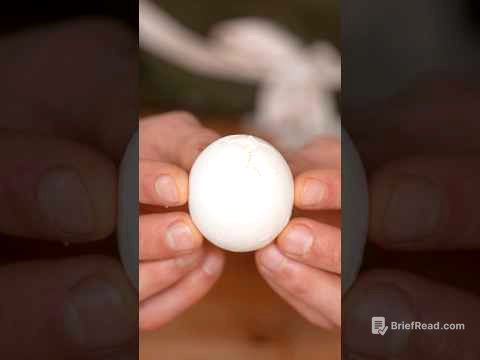TLDR;
This video provides an in-depth exploration of the types of women depicted in the Quran and Sunnah, categorized by their roles (wife, mother, single) and time periods (before and during the Prophet Muhammad's era). It highlights the special status of women in Islam, emphasizing their capacity to bring completeness to their partners and families. The lecture also addresses potential challenges in marital life, offering guidance on how to navigate them with faith and wisdom, drawing inspiration from figures like Sayidah Hawa and Asiah.
- Explores types of women in the Quran and Sunnah.
- Categorizes women by roles and time periods.
- Emphasizes the special status and completeness women bring.
- Offers guidance on navigating marital challenges with faith and wisdom.
Introduction: Blessings and the Role of Faith [0:04]
The lecture begins with a prayer and expresses hope that all attendees are blessed by Allah. A blessing is defined as a constant increase in good values consistently carried out in life. The speaker emphasizes that faith is always paired with goodness in the Quran. He uses the example of eyes, explaining that a believer's eyes are guided by their faith to see only what is good, and to turn away from what is not good, which is called "gaddul bashar." The speaker also highlights the importance of maintaining the originality of Islamic teachings, such as the Arabic call to prayer, which creates a vibration in the hearts of believers.
The Standard of Faith and Good Deeds [2:39]
The lecture addresses the standard of faith, questioning whether individuals have felt its influence in their lives. It notes that even chips have standards (spicy level 1, level 2), prompting reflection on the strength of one's faith. The speaker explains that strong faith is not only seen in enthusiasm for obedience but also in good deeds. Successful prayer leads to abstaining from evil, and successful Quran scholars create goodness from the verses they read. The lecture poses the question of whether there is guidance in the Quran that leads women to be the best before Allah and prove their faith.
Introduction to Types of Women in the Quran and Sunnah [13:57]
The speaker introduces the topic of types of women in the Quran and Sunnah, clarifying that the discussion will build a solid principle about women before returning to examples from the lives of the Prophet's wives. He apologizes for sitting higher than the congregation to facilitate better visibility and interaction. The speaker encourages Muslim men to follow along to identify which type their wives at home fit into. He emphasizes understanding over memorization, focusing on the perspective of the past and the era of Prophet Muhammad.
Categorizing Women in the Quran Before the Prophet's Era [15:52]
The speaker categorizes women mentioned in the Quran before the era of Prophet Muhammad. The first example is Sayidah Hawa, the wife of Prophet Adam, referencing Surah Al-Baqarah verse 35. Other examples include the wives of Prophet Noah and Prophet Luth, noting that their names are not explicitly mentioned. The speaker explains that when a woman's name is not mentioned, it indicates that the character and circumstances apply to women in the future. He also mentions Sayidah Sarah and Sayidah Hajar, the wives of Prophet Ibrahim, as well as Maryam, the daughter of Imran and Hannah.
More Examples of Women Before the Prophet's Era [22:47]
The speaker continues listing examples of women before the Prophet's era, including Lady Asiah, the wife of Pharaoh, and the mother and sister of Prophet Moses. He also mentions the two daughters of Prophet Shuaib, the wife of an Egyptian noble (Imraatul Aziz), and Queen Balqis. Additionally, he includes Imran's wife (Maryam's mother) and the wife of Prophet Zakaria.
Women During the Prophet Muhammad's Era and Categorization [26:33]
The speaker lists women mentioned during the era of Prophet Muhammad, including Sayidah Aisyah, Sayidah Hafsah, Sayidah Zainab, Khaula, and Abu Lahab's wife. He then divides the 19 women into two groups: 14 who lived before the Prophet's era and 5 who lived during it. The speaker further categorizes these women by marital status (married vs. unmarried) and motherhood (genetic vs. adopted children).
Analysis of Marital Status and Motherhood [31:56]
The speaker analyzes the marital status and motherhood of the 19 women. He identifies 16 as wives and 11 as genetic mothers, with 2 having adopted children. The remaining 3 are identified as unmarried. The speaker emphasizes that the discussion will focus on women as children, wives, and mothers, setting the stage for a deeper exploration of their roles and characteristics.
The Significance of Zauj and Completeness in Marriage [40:06]
The speaker begins by discussing Sayidah Hawa, emphasizing that her character and position are shown in the Quran, indicating that her experiences will be relevant to women in the future. He references Surah Al-Baqarah verse 35, highlighting the special status of a wife in Islam. The term "zauj" is explained as a pair that complements each other, emphasizing completeness rather than sameness. The speaker uses the analogy of right and left hands to illustrate how couples complement each other, bringing completeness to the relationship.
The Importance of Seeing Advantages Over Shortcomings [51:18]
The speaker uses the analogy of a black dot on a white circle to illustrate that in marriage, it's important to focus on the advantages (white space) rather than the shortcomings (black dot). He emphasizes that Allah elevates the status of a wife, and this privilege should be used for good. The speaker references Quran Surah 4 verse 19, advising husbands not to pass on their bad traits to their wives and encouraging wives to be happy when they find shortcomings in their husbands, as it highlights their function as a wife.
Husbands in the Quran: The Busy and the Problematic [58:31]
The speaker discusses the types of husbands depicted in the Quran, starting with the "good but busy" example of Prophet Ibrahim. He notes that Prophet Ibrahim's busyness was directed towards good activities approved by Allah. The speaker highlights the challenges faced by Sayidah Hajar, who was left in a barren place with her newborn child. He emphasizes that Sayidah Hajar did not get angry but trusted in Allah's command. The speaker then transitions to the example of Pharaoh, representing a problematic husband.
The Example of Pharaoh and the Role of the Wife [1:16:56]
The speaker contrasts Prophet Ibrahim with Pharaoh, who represents a husband with negative qualities. He explains that Pharaoh's activities were not good, and his wife, Asiah, faced extreme challenges. The speaker references Quran chapter 2 verse 49, describing Pharaoh's cruelty in killing newborn boys. He poses the question: if Asiah could handle being married to Pharaoh, why can't modern women handle their less extreme marital problems? The speaker emphasizes that Allah provides tools to provide peace to the soul, even in difficult situations.
Navigating Marital Problems and the Importance of Studying Solutions [1:25:12]
The speaker discusses how to navigate marital problems, emphasizing that there is no household life without problems. He advises against being too serious and highlights the importance of jokes and humor in maintaining a healthy relationship. The speaker also touches on more serious issues, such as a husband becoming difficult to pray with or asking his wife to compromise her values. He mentions that the Quran provides solutions for these problems, including wisdom, mediation, and careful consideration before divorce.
Conclusion: Good and Bad Types of Women in the Quran [1:34:03]
In conclusion, the speaker summarizes that the types of women in the Quran can be divided into good and bad. Good women maintain their honor (ifah), and Allah makes their sustenance easier and answers their prayers quickly. The speaker provides examples of how to apply ifah in appearance, as a wife, and as a mother. He also mentions three bad types of women: instigators, teasers, and traitors, referencing figures like Abu Lahab's wife, Imraatul Aziz, and the wives of Prophet Nuh and Prophet Luth. The lecture ends with a prayer and an announcement about an upcoming guest speaker.
![[LIVE] Kajian Muslimah: Tipe Perempuan dalam Al-Qur'an - Ustadz Adi Hidayat](https://wm-img.halpindev.com/p-briefread_c-10_b-10/urlb/aHR0cDovL2ltZy55b3V0dWJlLmNvbS92aS9JMDJzY0k0Y0l3WS9tYXhyZXNkZWZhdWx0LmpwZw==.jpg)








